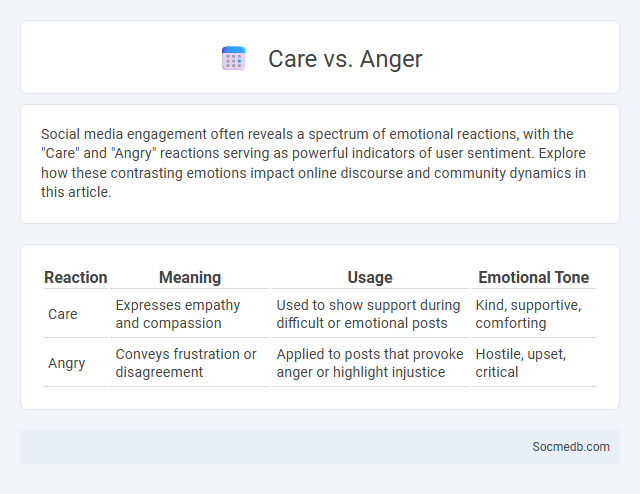
Photo illustration: Care vs Angry
Social media engagement often reveals a spectrum of emotional reactions, with the "Care" and "Angry" reactions serving as powerful indicators of user sentiment. Explore how these contrasting emotions impact online discourse and community dynamics in this article.
Table of Comparison
| Reaction | Meaning | Usage | Emotional Tone |
|---|---|---|---|
| Care | Expresses empathy and compassion | Used to show support during difficult or emotional posts | Kind, supportive, comforting |
| Angry | Conveys frustration or disagreement | Applied to posts that provoke anger or highlight injustice | Hostile, upset, critical |
Understanding Emotional Responses: Care, Anger, and Reactions
Social media platforms trigger complex emotional responses such as care, anger, and varied reactions by amplifying personal and collective experiences. Algorithms prioritize content that elicits strong emotions, increasing engagement through emotionally charged posts and comments. Recognizing these emotional dynamics aids in developing strategies for healthier online interactions and mitigating the spread of negativity.
Defining Care: Compassion in Action
Defining care as compassion in action on social media emphasizes empathetic engagement and authentic support within online communities. Platforms like Facebook, Instagram, and Twitter enable users to share personal stories, offer encouragement, and mobilize aid during crises, demonstrating care through meaningful interactions. The integration of positive communication algorithms enhances visibility of supportive content, reinforcing social bonds and collective well-being.
Exploring Anger: Causes and Triggers
Social media platforms catalyze anger through exposure to polarizing content, misinformation, and echo chambers that amplify emotional responses. Algorithm-driven feeds often prioritize sensational and provocative posts, increasing user engagement by triggering frustration and outrage. Personal experiences, societal issues, and perceived injustices further serve as significant triggers, making anger a pervasive emotion shaped by digital interactions.
The Psychology Behind Emotional Reactions
Social media platforms amplify emotional reactions by exploiting the brain's reward system, triggering dopamine releases with likes and shares that reinforce user engagement. Emotional contagion occurs as users mimic expressions and sentiments seen in posts, fostering a sense of belonging or triggering polarization. Understanding these psychological mechanisms helps explain why emotionally charged content spreads rapidly and influences online behavior.
Care vs. Anger: Impact on Relationships
Social media interactions driven by care foster trust and strengthen relationships by promoting empathy and positive communication. In contrast, experiences dominated by anger can escalate conflicts, damage reputations, and create emotional distance among users. Understanding the emotional tone, whether supportive or hostile, is crucial for maintaining healthy digital connections.
How Reactions Shape Outcomes
Social media reactions significantly influence content visibility and user engagement by signaling relevance to algorithms, which prioritize posts with higher interaction. Positive reactions such as likes, shares, and comments amplify message reach, while negative feedback can limit exposure or prompt content review. These response dynamics shape online discourse, affecting brand reputation, user sentiment, and digital marketing strategies.
Managing Care and Anger in Daily Life
Effective social media management can help you regulate emotions by providing tools to monitor interactions and avoid triggers that escalate anger. Using privacy settings and scheduled breaks minimizes exposure to content that might provoke stress or negative reactions. Consistent reflection on your online behavior supports healthier communication and reduces emotional overload in daily life.
Positive vs. Negative Emotional Responses
Social media platforms trigger a range of emotional responses, with positive effects including enhanced social connection, support, and self-expression, which contribute to improved well-being and community building. Conversely, exposure to negative content, cyberbullying, and social comparison can lead to anxiety, depression, and reduced self-esteem. Understanding these contrasting emotional impacts is essential for developing healthier online habits and fostering digital environments that promote mental health.
Strategies for Healthy Emotional Reactions
Social media users can cultivate healthy emotional reactions by setting time limits to avoid digital overload and curating feeds that promote positive and supportive content. Engaging in mindful consumption--critically evaluating posts and recognizing unrealistic portrayals--reduces comparison and anxiety. Regular digital detoxes combined with active offline socialization strengthen emotional resilience and mental well-being.
Building Emotional Intelligence: Balancing Care and Anger
Building emotional intelligence on social media requires recognizing your feelings while maintaining respectful communication. Understanding the balance between expressing care and managing anger helps create meaningful interactions and fosters positive relationships. Your ability to navigate emotions thoughtfully enhances both personal growth and online community well-being.
 socmedb.com
socmedb.com